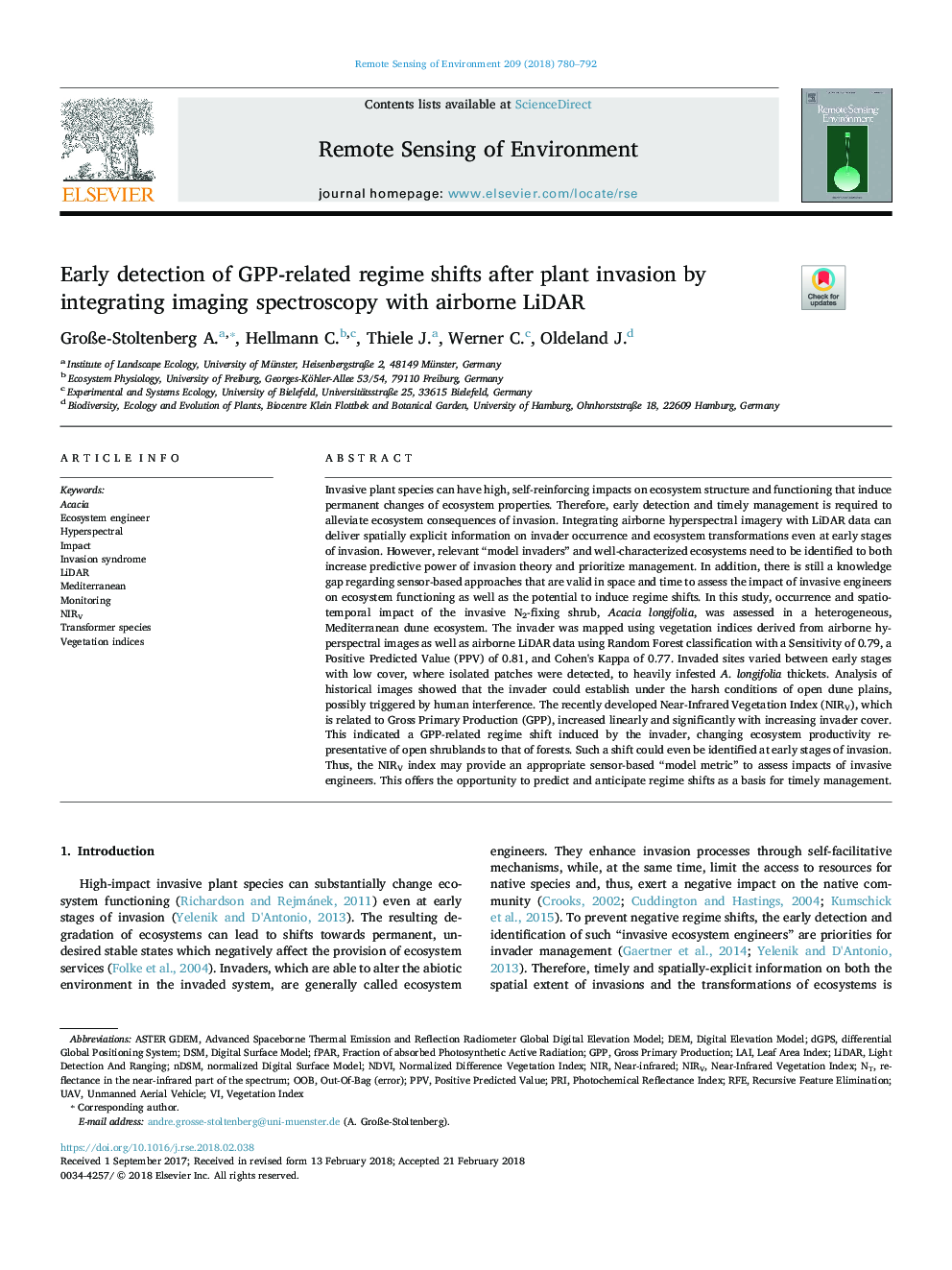| کد مقاله | کد نشریه | سال انتشار | مقاله انگلیسی | نسخه تمام متن |
|---|---|---|---|---|
| 8866679 | 1621191 | 2018 | 13 صفحه PDF | دانلود رایگان |
عنوان انگلیسی مقاله ISI
Early detection of GPP-related regime shifts after plant invasion by integrating imaging spectroscopy with airborne LiDAR
دانلود مقاله + سفارش ترجمه
دانلود مقاله ISI انگلیسی
رایگان برای ایرانیان
کلمات کلیدی
ASTER GDEMDGPSPPVGPPPRIRFEFPARNIRDSMDemAcacia - آکاسیاOOB - اوبHyperspectral - بیش از حدLight detection and ranging - تشخیص نور و محدودهGross primary production - تولید ناخالص اولیهRecursive feature elimination - حذف ویژگی های بازگشتیPhotochemical reflectance index - شاخص بازتابی عکس شیمیاییnormalized difference vegetation index - شاخص تنوع گیاه شناسی نرمال شدهLeaf area index - شاخص سطح برگNDVI - شاخص نرمالشده تفاوت پوشش گیاهی Vegetation indices - شاخص های گیاهیVegetation index - شاخص گیاهیLAI - شبیهImpact - ضربهLiDAR - لیدار digital elevation model - مدل ارتقاء دیجیتالDigital surface model - مدل سطح دیجیتالMediterranean - مدیترانه Ecosystem engineer - مهندس اکوسیستمNear-infrared - نزدیک مادون قرمزMonitoring - نظارتUnmanned Aerial Vehicle - وسیلهی نقلیهی هوایی بدون سرنشینUAV - پهپاد
موضوعات مرتبط
مهندسی و علوم پایه
علوم زمین و سیارات
کامپیوتر در علوم زمین
پیش نمایش صفحه اول مقاله

چکیده انگلیسی
Invasive plant species can have high, self-reinforcing impacts on ecosystem structure and functioning that induce permanent changes of ecosystem properties. Therefore, early detection and timely management is required to alleviate ecosystem consequences of invasion. Integrating airborne hyperspectral imagery with LiDAR data can deliver spatially explicit information on invader occurrence and ecosystem transformations even at early stages of invasion. However, relevant “model invaders” and well-characterized ecosystems need to be identified to both increase predictive power of invasion theory and prioritize management. In addition, there is still a knowledge gap regarding sensor-based approaches that are valid in space and time to assess the impact of invasive engineers on ecosystem functioning as well as the potential to induce regime shifts. In this study, occurrence and spatio-temporal impact of the invasive N2-fixing shrub, Acacia longifolia, was assessed in a heterogeneous, Mediterranean dune ecosystem. The invader was mapped using vegetation indices derived from airborne hyperspectral images as well as airborne LiDAR data using Random Forest classification with a Sensitivity of 0.79, a Positive Predicted Value (PPV) of 0.81, and Cohen's Kappa of 0.77. Invaded sites varied between early stages with low cover, where isolated patches were detected, to heavily infested A. longifolia thickets. Analysis of historical images showed that the invader could establish under the harsh conditions of open dune plains, possibly triggered by human interference. The recently developed Near-Infrared Vegetation Index (NIRV), which is related to Gross Primary Production (GPP), increased linearly and significantly with increasing invader cover. This indicated a GPP-related regime shift induced by the invader, changing ecosystem productivity representative of open shrublands to that of forests. Such a shift could even be identified at early stages of invasion. Thus, the NIRV index may provide an appropriate sensor-based “model metric” to assess impacts of invasive engineers. This offers the opportunity to predict and anticipate regime shifts as a basis for timely management.
ناشر
Database: Elsevier - ScienceDirect (ساینس دایرکت)
Journal: Remote Sensing of Environment - Volume 209, May 2018, Pages 780-792
Journal: Remote Sensing of Environment - Volume 209, May 2018, Pages 780-792
نویسندگان
GroÃe-Stoltenberg A., Hellmann C., Thiele J., Werner C., Oldeland J.,